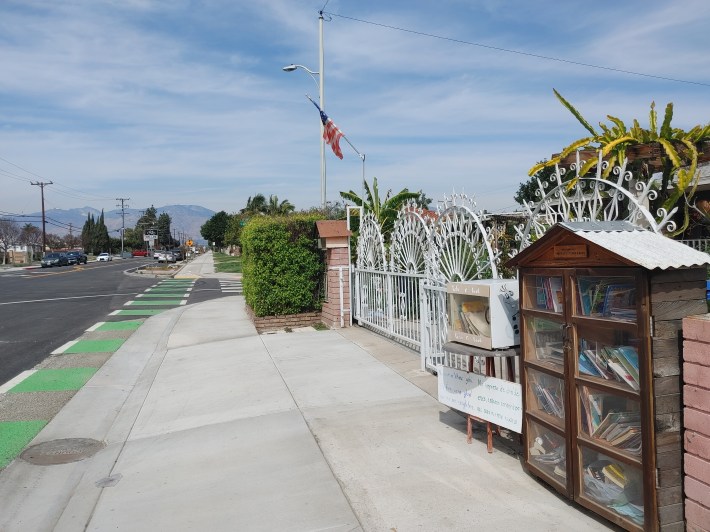The drivers of the biggest vehicles on U.S. roads can't even see many of the people in their path — and cities could be doing more right now to stop blind-spot deaths, a recent panel of experts argued.
In a presentation last week for the 2021 Vision Zero Cities Conference, a consortium of safety leaders explored the impact of large commercial and service vehicles on roadway safety and what communities can do right now to make buses, sanitation trucks, big rigs, fire trucks and other large vehicles a little safer for the vulnerable road users they drive amongst.
Those changes can't come soon enough. Heavy-duty vehicles represent just four percent of the U.S. fleet and require special licenses to operate, but their drivers are still involved in seven percent of pedestrian fatalities, 11 percent of cyclist fatalities, and 12 percent of car-occupant deaths, thanks in large part to dangerous vehicle designs with massive blind-spot zones that federal safety regulators continually allow automakers to produce.
According to the Vehicle Blind Zone calculator, a 2022 MACK Granite truck like the one pictured above has a front and side blind spot zone wide enough to completely obscure a crowd of a staggering 187 average-height adults clustered around the front and sides of the cab.

And that's not where their deadly impact ends. Because dangerous, ultra-wide cars require dangerous, ultra-wide roads to drive on, experts argue that cities that actively accommodate truck traffic are functionally encouraging the drivers of smaller cars to behave recklessly, too.
"Much of the time, we’re designing our roads for the biggest possible vehicle who could come down it," said Kate Fillen-Yeh, director of strategy for NACTO and one of the presenters. "Which means that the rest of the time, when that big truck isn’t there, everyone else is on a road that encourages them to drive faster and less [responsibly]."
Some U.S. cities are already experimenting with ways to get some mega-vehicles off the roads altogether, including bans on semi-trailer parking in urbanized areas, e-cargo bike pilots that replace package delivery trucks in the downtown core, two-wheeled emergency service vehicles that can supplant full-scale ambulances for calls that don't need to transport passengers, and more.
But when it comes to big autos that must remain on neighborhood streets, like buses, the panelists stress that better vehicle design standards are key — and cities can't afford to wait until the federal government starts requiring them.
The experts made particular note of traffic safety leaders in London, England, who have already adopted a "Direct Vision" standard for every truck allowed within city limits. The program scores commercial vehicles according to their ability to see pedestrians and other people outside vehicles on a scale of one to five stars; trucks with wide, wrap-around windows and low-set "cab-over" designs that situate the driver above the engine and close to walking traffic tend to score the highest, because they make it possible to see even the shortest passerby. (Fillen-Yeh notes appreciatively that, unlike in the U.S., Direct Vision uses the an adult woman of average height as their design standard rather the average man, who is significantly taller.)
Lorries with one star are allowed to operate on British roads for now, but trucking companies and other providers will be required to make their fleets safer in the years to come — and experts say those upgrades aren't as expensive as many would assume. Even conventional trucks can be retrofit with larger side-view windows that enhance visibility, along with 360 degree cameras, advanced driver assistance systems, and other safety features that can cut the time it takes a driver to see and react to a pedestrian she might strike.
And when it comes time to switch out a bad big rig altogether, the panelists said safer vehicles often don't even cost more than the dangerous ones they're replacing — especially if design changes are made in tandem with electrifying city fleets, as countless municipalities have already committed to do.
"We’re not really paying a high premium for a [direct vision vehicle] right now," said Keith Kerman, chief fleet officer for the New York City Department of Citywide Administrative Services and a presenter on the panel. "There would be a an upfront cost to do that [for automakers]. But once that choice is made, it doesn't cost more [to manufacture a safer truck, bus or other auto]."
Kerman says cities themselves can play a major role in keeping those costs down — especially among big metropolises with a lot of purchasing power.
His department is supervising the acquisition of safety equipment for tens of thousands of city vehicles, including surround-view cameras, live telematics, back-up alarms, automatic emergency braking systems and more. There were hardly any vendors for many of these technologies just a few years ago — until the Big Apple started placing orders, that is.
"Sometimes, we really had to create the marketplace," Kerman laughed.
But getting more holistically safe mega-vehicles on the road is challenging even for Gotham, because the automakers that manufacture them tend to send most of their trucks to Europe, where there's a more robust market.
"We know we want these trucks," said Kerman. "Now, we want to see the trucking industry move to supply them…They know how to make them. They’re already selling them. They’re just not selling them here."

Of course, as SUVs and ultra-huge consumer trucks increasingly saturate U.S. roads, the vehicles the pros drive aren't the only ones threatening America's pedestrians. But the panel says reforming the vehicle safety standards that control all vehicle classes is possible — and advocates have a chance to make their voices heard right now.
"The National Highway Traffic Safety Administration is accepting comments on their safety research portfolio, and this would be a great time for everyone to tell them to study direct vision comparatively for both trucks and SUVs," added Fillen-Yeh. "[It's time we] start talking about what a national vehicle standard around vision might look like."







